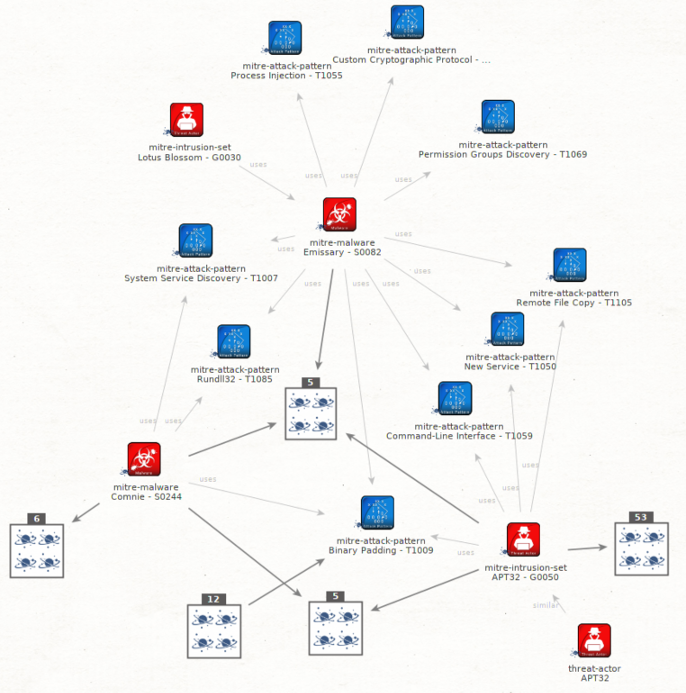mirror of https://github.com/MISP/MISP-maltego
77 lines
5.3 KiB
Markdown
77 lines
5.3 KiB
Markdown
# MISP-Maltego User Guide
|
|
|
|
This user guide should help you through the installation of **MISP-Maltego**, and should guide you how to use it through a few use-cases. As this is a collaborative project, do not hesitate to propose changes, write other use-cases or raise [feature requests](https://github.com/MISP/MISP-maltego/issues) for missing features.
|
|
|
|
## Installation
|
|
These instructions have been tested on Ubuntu 18.04 LTS, but should be similar on other systems.
|
|
1. Download and install [Maltego](https://www.paterva.com/web7/downloads.php)
|
|
2. Install using pip: `pip3 install MISP-maltego`
|
|
3. Generate the Maltego bundle: `canari create-profile MISP-maltego`
|
|
4. Import this bundle in Maltego.
|
|
1. Open Maltego
|
|
2. Click on the home button (Maltego icon, top-left corner).
|
|
3. Click on 'Import'
|
|
4. Click on 'Import Configuration'.
|
|
5. Load the `MISP_maltego.mtz` file and follow the prompts.
|
|
5. Edit `$HOME/.canari/MISP_maltego.conf` and enter your `misp_url` and `misp_key`
|
|
|
|
## Custom Entities
|
|
MISP-Maltego tries to use as much as possible the default Paterva entities, or the most popular from the community. It however comes with a few custom entities:
|
|
* **MISPEvent**: A representation of an *Event* on MISP, containing *Attributes* (MISP) / *Entities* (Maltego)
|
|
* **MISPObject**: A way to group associated attributes in a structured way.
|
|
* **MISPGalaxy**: A *Tag* containing much more metadata. Please refer to the [MISP Galaxy
|
|
](https://github.com/MISP/misp-galaxy) for more information. **MITRE ATT&CK** is for example completely available through MISPGalaxy entities (see use-cases for an example)
|
|
|
|
# Use Cases
|
|
## Transform on existing data
|
|
In this use case we will be using already existing entities and will initiate a transform using MISP. The currently supported entities are: `AS`, `DNSName`, `Domain`, `EmailAddress`, `File`, `Hash`, `IPv4Address`, `NSRecord`, `Person`, `PhoneNumber`, `URL`, `Website`.
|
|
|
|
Example:
|
|
* create an entity `domain` with the value `1dnscontrol.com`.
|
|
* right click and choose *Local Transforms* > *MISP_maltego* > *Domain To Event*
|
|

|
|
* continue loading transforms on the *MISP Event*
|
|
|
|
## Transform from MISP Event ID
|
|
While MISP already has a graphing capability we would like to use the power of Maltego to look at the data and expand the work.
|
|
* Create a *MISP Event* and give it an `event id`, or `UUID`
|
|
* One **manual** way is to right click and choose *Local Transforms* > *MISP_maltego* > *Event To Attributes*
|
|
* Notice the event is transformed to *Attributes*, *Objects*, *Tags*, *Galaxies* and related *MISP Events*
|
|
* You can now further transform on an *Object* > *Object To Attributes* and see the content of the object
|
|

|
|
* Alternatively you can also use the **Maltego Machine** to speed up things.
|
|
* Click on the *MISP Event* and in the left menu choose *Event to All* in the *Machines* section.
|
|

|
|
* Notice that the whole event, objects and such will get expanded with data from your MISP instance.
|
|

|
|
* You can now further transform on any data.
|
|
|
|
## Which data is already in MISP?
|
|
If you use MISP as central database it can be quite convenient to know which data is present in MISP, and which data is not; especially after using a number of other transforms.
|
|
To permit this MISP-Maltego will always add a green bookmark to all the data that is present in MISP.
|
|

|
|
|
|
|
|
## Transform from Galaxy
|
|
Galaxies are actually tags with much more contextual data. Examples are threat actors, malware families, but also the whole MITRE ATT&CK data is available as Galaxy. All this data comes from the [MISP Galaxy](https://github.com/MISP/misp-galaxy) repository. Today the integration is not done using a MISP server because of limitations in MISP.
|
|
You might encounter Galaxies when transforming from MISP Events or Attributes. An alternative use-case is by starting immediately from a Galaxy.
|
|
There are 3 ways to manually create a good Galaxy Entity.
|
|
1. Using a find capability (see below)
|
|
2. Create the Galaxy and set the UUID. You can find the UUIDs in the [MISP Galaxy](https://github.com/MISP/misp-galaxy) repository.
|
|
3. Create the Galaxy with the right tag name; for example: `misp-galaxy:`
|
|
|
|
To use the magical search feature:
|
|
* Create a *MISP Galaxy* and type the keyword as value.
|
|
* Run the *Galaxy To Relation* transform, notice the search results will appear as connected entities
|
|
* Remove the non-relevant entities, including the your search-keyword
|
|

|
|
|
|
## Visualize MITRE ATT&CK
|
|
Apply the same steps for MITRE ATT&CK browsing:
|
|
|
|

|
|
|
|
You might end up with such a graph:
|
|
|
|

|